How to Make Whipped Soap - Your No-Fail Recipe!
During the summer months, there’s nothing quite as refreshing as bathing with a beautifully scented skin loving cleansing product. Whipped soap is extremely easy to make and we will show you step-by-step how to make this gorgeous product for yourself.

It can be used as a body wash, shower fluff or you can put a scoopful under the running taps and use as a moisturising bubble bath.
Our watermelon-scented whipped soap is a lovely light and fluffy alternative to bath/shower gel and solid soap bars. Full of skin-loving ingredients including apricot kernel oil, you will be left feeling clean, smelling beautiful and the best bit is feeling wonderfully moisturised.
Jump straight in with our video tutorial below or scroll down to check out a step by step written tutorial with pictures as well as further information on creating your own bespoke versions of our whipped soap recipe.
Our tutorial is meant for personal use only. If you’d like to sell whipped soap products, you’ll need to purchase our OPC Whipped Soap Assessment and follow the guidelines on selling your bath and body products as laid out in our blog post here.
Difficulty Level: Beginner to Intermediate
Makes: 5 x 200ml volume containers
Ingredients
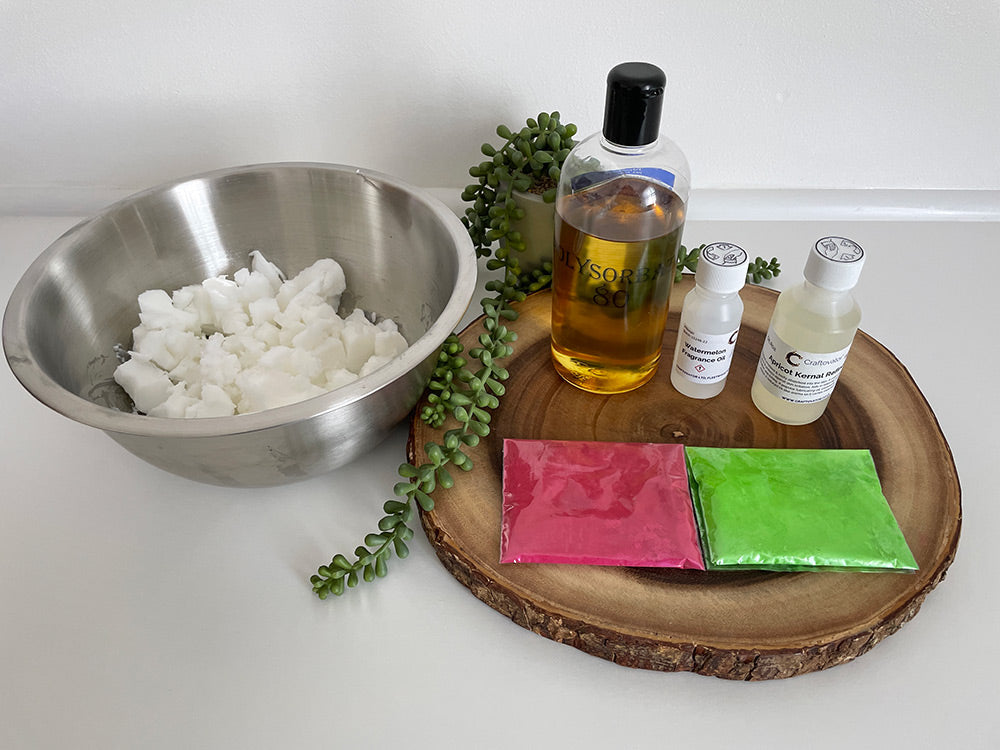
- 600g Crystal OPC Base
- 18g Watermelon Fragrance Oil
- 6g Apricot Kernel Refined Oil
- 6g Polysorbate 80
- 6g Fantasia Pink Mica Powder
- 6g Pistachio Mica Powder
Equipment
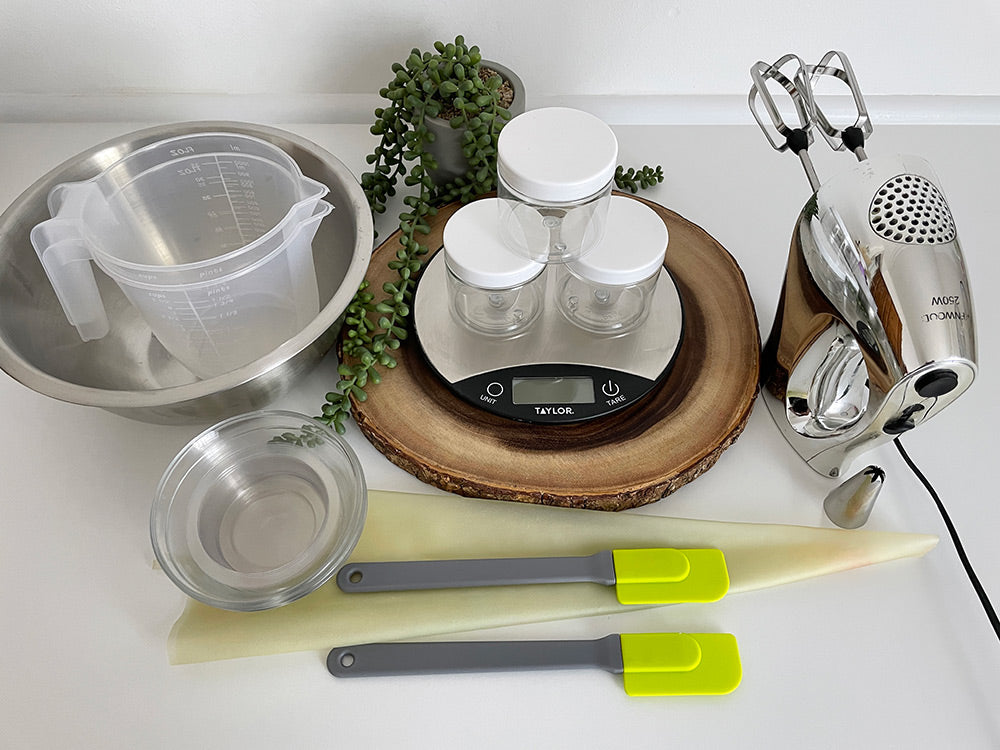
- Weighing scales
- An electric hand or stand mixer
- Large mixing bowl
- Selection of smaller bowls for your ingredients
- Suitable containers for your end product
- 2 jugs
- A large piping nozzle and piping bag (optional*)
- A couple of spatulas
*A piping bag is optional. If you wish, you can simply spoon the soap your containers.
Note: Mica powder can either be mixed with a little isopropyl alcohol or can be added directly to the base. If using isopropyl alcohol, add a small amount to the mica powder and mix well to fully disperse before adding to your base.
Step 1 – Prep & Weigh Your Ingredients

Prepare your workspace. Weigh out all of your ingredients before you start as this will make it a little easier going through the making process.
Step 2 – Chop & Whip Base
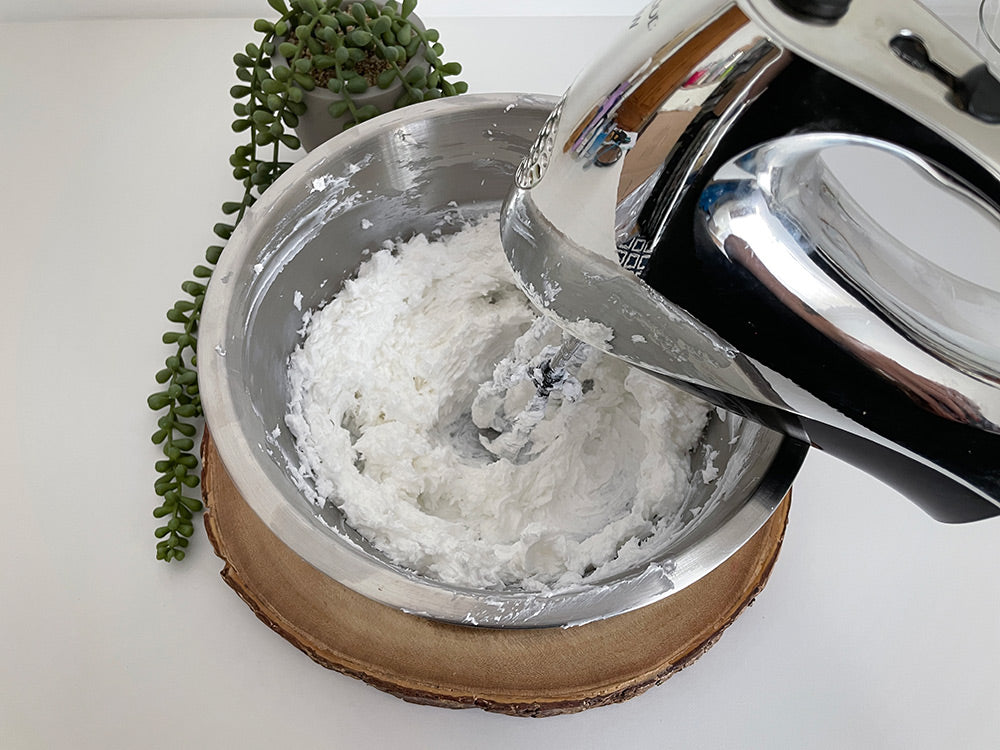
Take your 600g of OPC base and chop up into small pieces. This will help the whipping process. Whip the base until you achieve a whipped cream consistency.
Step 3 – Add oils and additives

Now add your 18g of watermelon fragrance oil, 6g of apricot kernel oil and 6g of polysorbate80.
Step 4 – Whip Again
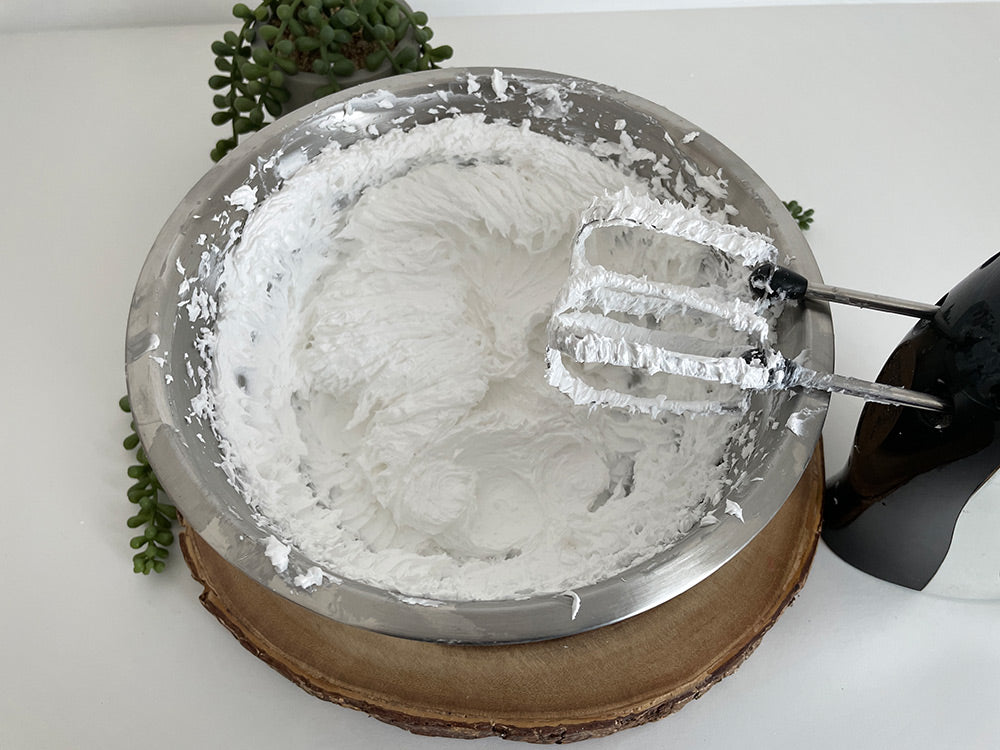
Continue to whip the base and with the added ingredients until the volume of the base roughly doubles in volume.
Step 5 – Split the Base and Add Colourant

As we are making a duel coloured whipped soap, split the base into 2 separate containers.
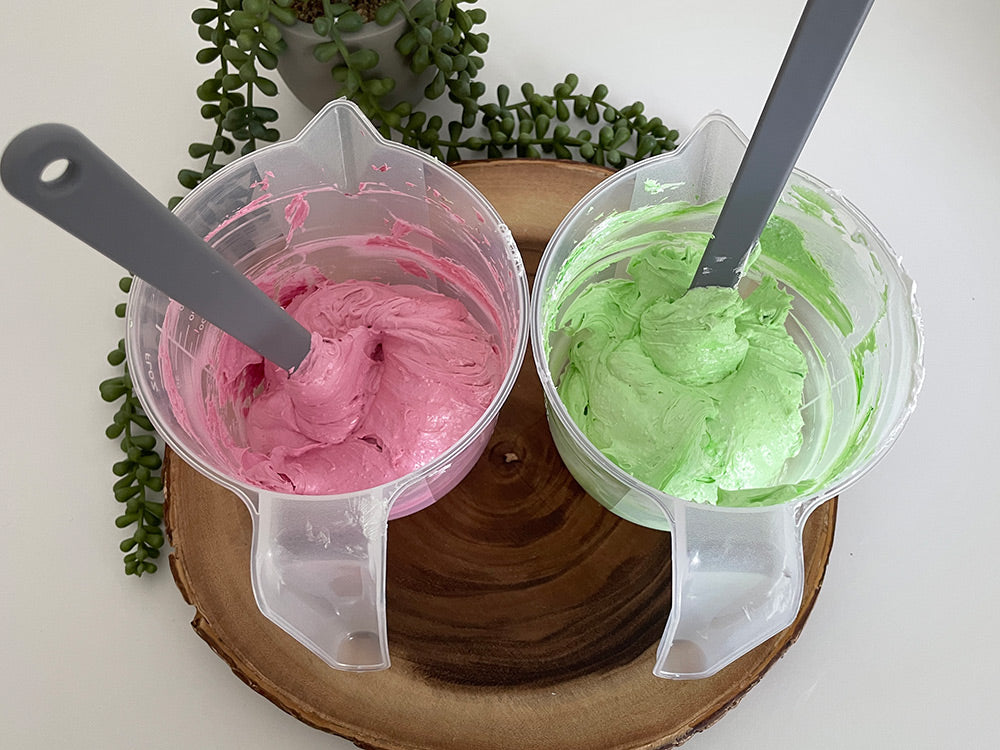
Add your colouring to each container and whisk until fully combined.
Step 6 – Prepare the Piping Bag
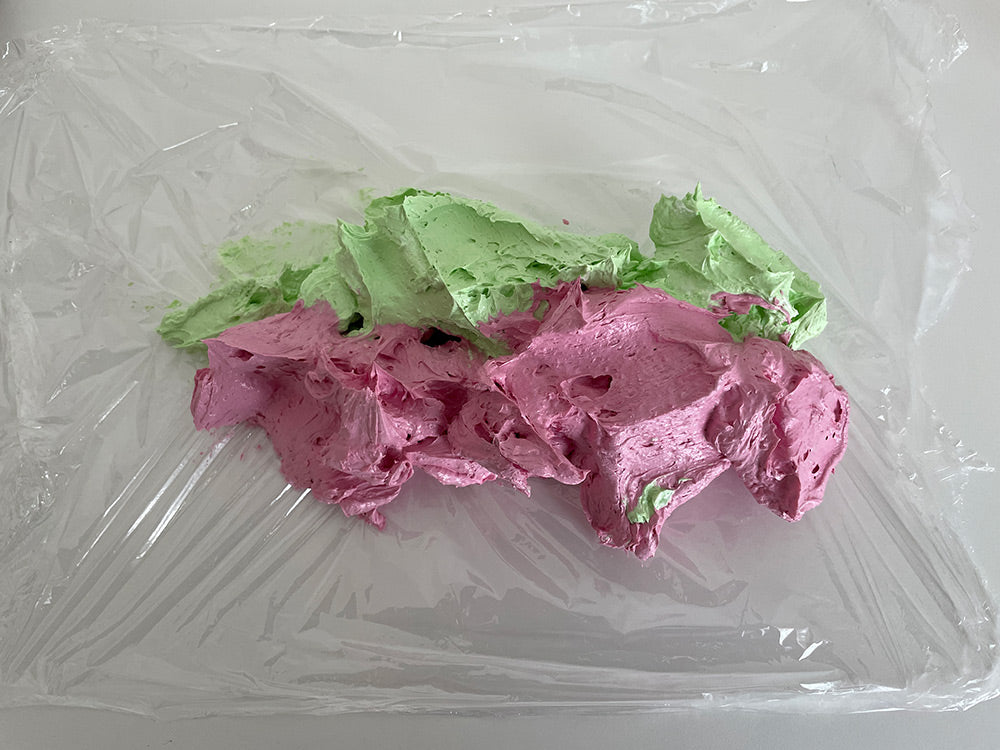
If you are using a piping bag, place a piece of clingfilm on to the counter and lay the 2 coloured mixes next to each other.

Fold up the sides of the clingfilm and mould and shape the mixture, making sure you squeeze out and air pockets that may be present.
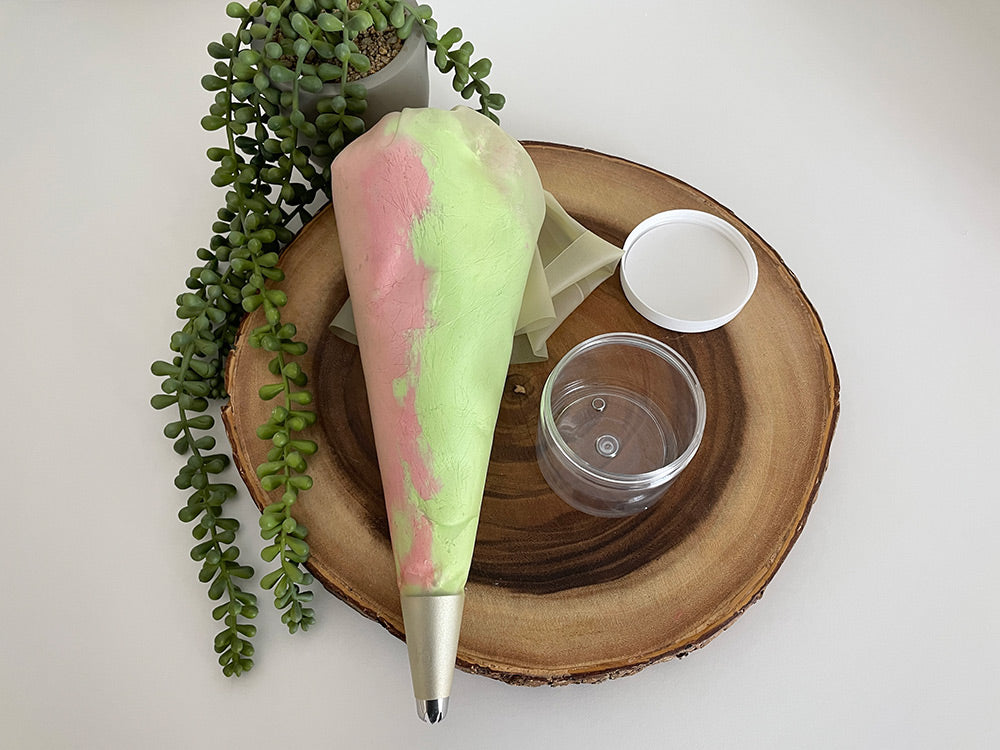
Roll up the ends and using scissors, snip one end and place inside the piping bag.
Step 7 – Pipe the Mixture
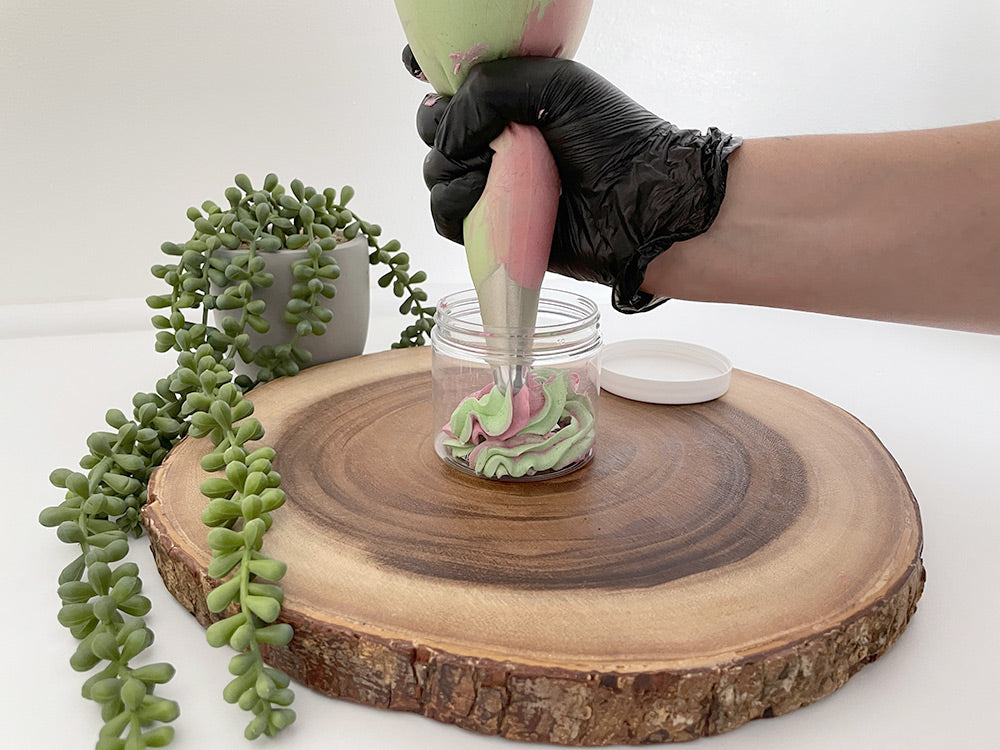
Pipe the mixture into your containers.
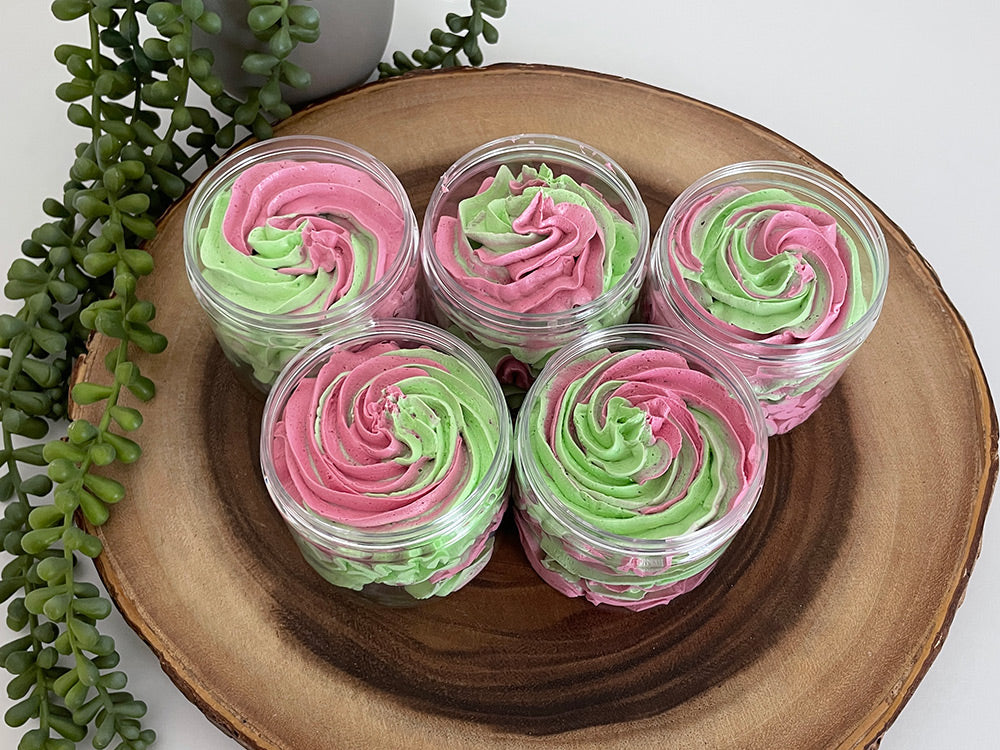
Your whipped soap is now ready! No time is needed for it to set so the product is ready to use immediately.
What Base Can I Use for Making Whipped Soap?
The easiest way to make whipped soap is with our Crystal OPC Base. This base is also known as Foaming Bath Butter.
This foaming bath butter base offers a high foaming, mild, non-irritant creamy cleanser for all skin types including sensitive skin. It can accommodate up to 2% of fragrance and additional additives.
What Fragrances Can I Use for Whipped Soap?
As with all “wash off” body products a 3% allowance of fragrance oil is permitted. When considering the total weight of your finished product, you want to ensure that no more than 3% of that total weight is made up of your fragrance oils.
For instance, if we are using 600g of opc base for our whipped soap, 3% of the total weight would be 18g of fragrance oil (600g x 0.03 = 18g).
Always measure your fragrance oils in weight, rather than in millilitres (which is a volume measurement). Oils will often differ in their viscosity (meaning some are thicker and some are thinner) so even at the same volume, you will find they will be different weights. To account for this difference and to make things easier, all your ingredients should be using the same unit of measure - in this case, grams.
One important aspect of safety when using any kind of fragrance or essential oil is to make sure the oil you’ve chosen is skin safe. Click the link that says ‘IFRA 49TH AMENDMENT’ on the fragrance oil product listing to download the document.
Once downloaded, look for the header labelled as "Certificate of Conformity" and scroll to Category 9. If the IFRA document states the safe useage is less than 3%, we wouldn’t recommend using it in your wash off products. If the IFRA documents states that the safe usage is 3% or higher, then you can use up to the full 3%. However, even if the IFRA document gives a percentage of more than 3%, we would still advise never using more than 3% in your whipped soap.
For the Watermelon Whipped Soap tutorial, we use 3% of Watermelon Fragrance Oil.
How Can I Add Colour to My Whipped Soap?

One of our favourite bits of making your own whipped soap is allowing yourself to be as creative with colour as you like! With a wide choice of neon pigment colours, mica powders and water-soluble dyes, you can choose to make a single coloured, double coloured or even a rainbow-coloured whipped soap.
With any leave on product, the colour allowance is up to 3% of the overall base weight. We do find that you will rarely need to use that much colourant so our Watermelon Whipped Soap tutorial uses a total of 2%: Fantasia Pink Mica Powder at 1% and Pistachio Mica Powder at 1%.
Can I Use Other Additives in My Whipped Soap?
Yes, absolutely! We love to use additional skin-loving oils in our products where we can. Carrier oils are such a great way to add skin nourishing properties to a product. In our Watermelon Whipped Soap, we use apricot kernel oil. Apricot kernel oil is known for its multi-vitamin content and its fatty acids that help promote healthy hydrated skin. Because it’s a lovely light oil, it will not give you a greasy feel.
Because we are using a carrier oil in this product, we have also used a product called Polysorbate 80, which will help the oil as well as the mica powders disperse easily in the water. Without Polysorbate 80, you may find the oil clinging to the side or floating in the bathtub which means that the skin will not benefit from the oil and you will have to spend time cleaning out the bathtub!

We hope you’ve enjoyed our tutorial and our tips for making your own whipped soap. Looking for more tips on making your own soap? Check out our Melt & Pour Soap tutorial here.
Update! We're now stocking jars and caps for your whipped soap products!








10 Comments
Hello, I thought the base could only accommodate 2% of additional additives. I noticed your recipe contains about 42g of additives which is about 7%. Are fragrances and color additives excluded?
Hi
Please could you advise.
I would like to start making and selling whipped soap products on craft fayres.
Would I need to purchase different cpsr reports for different fragrances?
Also in the package would the legal labels be provided?
Kind regards
Judy
How long will it last after making it
What other oil can you use as use are out of apricot kernel oil
Hi Ruth, You absolutely can use essential oils if you wish! Just make sure you check the IFRA documentation for category 9 and similar to fragrance oils, as long as it gives a % of 3% or above, you’ll know it’s skin safe (you’ll still only want to use 3% regardless in your soap). Hope that helps! Kimberly – Craftovator
Leave a comment
All blog comments are checked prior to publishing